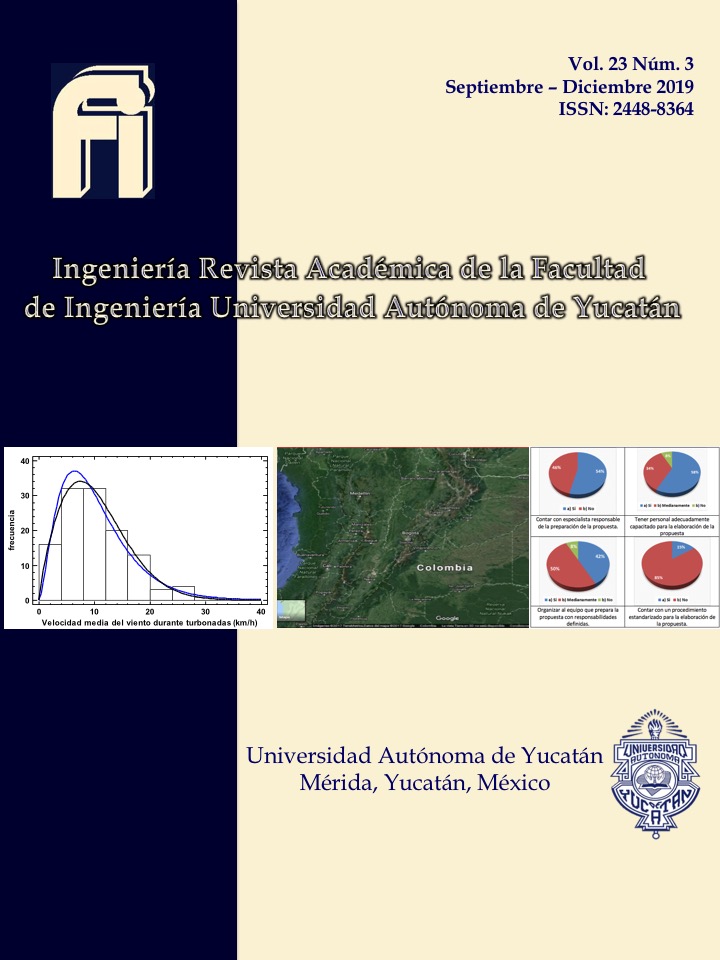Estimación de la conductividad térmica a partir de mediciones eléctricas usando la ley de Wiedemann-Franz para películas delgadas de tungsteno
Resumen
Usando RF sputtering se depositaron películas delgadas de tungsteno sobre sustratos de vidrio variando la presión de argón de 5 a 35 mTorr. Se determinaron experimentalmente en un sistema Hall las propiedades eléctricas de las muestras, encontrándose concentraciones de portadores del orden de 1022 huecos/cm3. Se midieron las conductividades eléctricas y se correlacionaron con los mecanismos de transporte del tungsteno erosionado en el gas de fondo. Utilizando estos valores se calcularon las conductividades térmicas por medio de la relación de Wiedemann-Franz. Los resultados obtenidos se encuentran dentro del rango reportado por otros autores, sugiriendo que las películas delgadas de tungsteno crecidas a bajas presiones de argón pueden utilizarse como parte de multicapas absorbedoras en colectores solares.
Citas
Dan, A., Chattopadhyay, K., Barshilia, H. C., & Basu, B. (2016). Angular solar absorptance and thermal stability of W / WAlN / WAlON / Al 2 O 3 -based solar selective absorber coating. Applied Thermal Engineering, 109, 997–1002. https://doi.org/10.1016/j.applthermaleng.2016.04.069
Hao, Q., Chen, W., & Xiao, G. (2015). Beta (β) tungsten thin films: Structure, electron transport, and giant spin Hall effect. Applied Physics Letters, 106(18), 182403.
Hostetler, J. L., Sm, A. N., & Norris, P. M. (1997). THIN-FILM THERMAL CONDUCTIVITY AND THICKNESS MEASUREMENTS USING PICOSECOND ULTRASONICS.
Hurd, C. (1972). The Hall effect in metals and alloys. Springer Science & Business Media.
Jin, Y., Kang, S., Oh, Y., Won, G., Ho, I., Nam, H., & Keun, Y. (2018). Materials Characterization Microstructural evolution and electrical resistivity of nanocrystalline W thin fi lms grown by sputtering. Materials Characterization, 145(July), 473–478. https://doi.org/10.1016/j.matchar.2018.09.016
Metz, W. A., Mahan, J. E., Malhotra, V., & Martin, T. L. (1984). Electrical properties of selectively deposited tungsten thin films. Applied Physics Letters, 44(12), 1139–1141.
Narasimham, A. J., Medikonda, M., Matsubayashi, A., Khare, P., Chong, H., Matyi, R. J., … LaBella, V. P. (2014). Fabrication of 5-20 nm thick β-W films. AIP Advances, 4(11), 117139.
Richardson, C. J. K., & Spicer, J. B. (2003). Characterization of heat-treated tungsten thin films using picosecond duration thermoelastic transients. Optics and Lasers in Engineering, 40, 379–391.
Rossnagel, S. M., Yang, I., & Cuomo, J. J. (1991). Compositional changes during magnetron sputtering of alloys. Thin Solid Films, 199(1), 59–69.
Somekh, R. E. (2014). The thermalization of energetic atoms during the sputtering process The thermalization of energetic atoms during the sputtering process. Vacuum Science & Technology, 1285(1984). https://doi.org/10.1116/1.572396
Vijaya, G., M, M. S., Krupashankara, M. S., Srinivas, M. R., & Kulkarni, R. S. (2018). ScienceDirect Development and Analysis of Tungsten Thin film Coating for Solar Absorption. Materials Today: Proceedings, 5(1), 2555–2563. https://doi.org/10.1016/j.matpr.2017.11.039
Wiedemann, R. F. G. (1853). Ueber die Wärme‐Leitungsfähigkeit der Metalle. Annalen Der Physik.

Esta obra está bajo licencia internacional Creative Commons Reconocimiento-NoComercial 4.0.
Avisos de derechos de autor propuestos por Creative Commons
1. Política propuesta para revistas que ofrecen acceso abierto
Aquellos autores/as que tengan publicaciones con esta revista, aceptan los términos siguientes:
- Los autores/as conservarán sus derechos de autor y garantizarán a la revista el derecho de primera publicación de su obra, el cuál estará simultáneamente sujeto a la Licencia de reconocimiento de Creative Commons que permite a terceros compartir la obra siempre que se indique su autor y su primera publicación esta revista.
- Los autores/as podrán adoptar otros acuerdos de licencia no exclusiva de distribución de la versión de la obra publicada (p. ej.: depositarla en un archivo telemático institucional o publicarla en un volumen monográfico) siempre que se indique la publicación inicial en esta revista.
- Se permite y recomienda a los autores/as difundir su obra a través de Internet (p. ej.: en archivos telemáticos institucionales o en su página web) antes y durante el proceso de envío, lo cual puede producir intercambios interesantes y aumentar las citas de la obra publicada. (Véase El efecto del acceso abierto).

